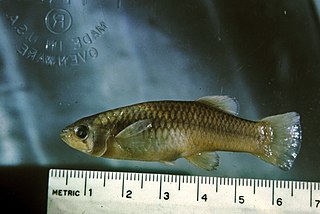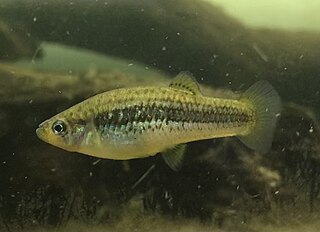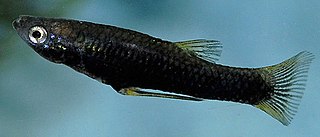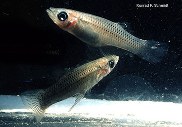
The western Mosquitofish is a North American freshwater fish, also known commonly, if ambiguously, as simply Mosquitofish or by its generic name, Gambusia, or by the common name gambezi. Its sister species, the eastern mosquitofish is also referred to by these names.

Gambusia is a large genus of viviparous fish in the family Poeciliidae. Gambusia contains over 40 species, most of which are principally found in freshwater habitats, though some species may also be found in brackish or saltwater habitats. The genus Gambusia comes from the Cuban term, "Gambusino", which means "free-lance miner". The type species is the Cuban gambusia, G. punctata. The greatest species richness is in Mexico, Texas, and the Greater Antilles, but species are also found elsewhere in the eastern and southern United States, the Bahamas, Central America, and Colombia. Gambusia species are often called topminnows, or simply gambusias; they are also known as mosquitofish, which, however, refers more specifically to two species, G. affinis and G. holbrooki, which are often introduced into ponds to eat mosquito larvae. As a consequence, they have been introduced widely outside their native range, and frequently become invasive, threatening local species. They are only occasionally kept in aquariums, due to their relative lack of color and the highly aggressive nature of the aforementioned mosquitofish species.
The widemouth gambusia is a species of fish in the family Poeciliidae of the order Cyprinodontiformes. It is endemic to Mexico, specifically to the Baños del Azufre near Teapa, Tabasco. The Baños del Azufre are sulfidic springs that contain high concentrations of toxic hydrogen sulfide. This prevents most animals from living in them; the only other fish found in the toxic sections of Baños del Azufre is the sulphur molly.

The eastern mosquitofish is a species of freshwater fish, closely related to the western mosquitofish, Gambusia affinis. It is a member of the family Poeciliidae of order Cyprinodontiformes. The eastern mosquitofish is native to the eastern and southern United States from Florida to Pennsylvania and inland to Alabama and Tennessee, while the western mosquitofish has a larger distribution throughout the United States.
The San Marcos gambusia is an extinct species of gambusia from the family Poeciliidae that was found only in the San Marcos Springs of Central Texas. The fish has not been seen since 1983. The specific name of this fish honors the American ichthyologist George S. Myers (1905-1985).
The Barrens topminnow is a species of freshwater fish in the family Fundulidae, which is in need of management so that it may continue to and increasingly survive in the wild. There are many potential causes of decline of this species including the invasive western mosquitofish that will replace native species on a population level, wadding piscivorous birds preying on adults, and the overall restricted distribution of the species. Managing for this species is vital for its success, but to do so there must be an understanding of the species' characteristics. It is endemic to a small portion of Tennessee in the Elk River and the West Hickory creek of the Cumberland river drainage. living up to only 3 years the life span of F. julisia is very short. In many cases the majority of the population does not even reach that age. Most adult males are eaten by birds because of their bright coloration during breeding season. Current management plans are in place for the improvement of the species such as captive breeding and reintroduction, and also private management of streams and land. Yet, more can be done to aid them in their survival efforts. Buffer zones around streams can be created to promote the health of the stream and close observation of the introduced populations needs to be a priority. With only three small original populations left in the wild it is important that species survive in captivity, but more so in its natural environment.
The yellowfin gambusia is a species of fish in the family Poeciliidae. It is endemic to the Rio Conchos of Chihuahua, Mexico, where it is known as guayacon de san gregorio. This species was described in 1957 by Clark Hubbs and Victor G. Springer with the type locality given as El Ojo de San Gregorio in Chihuahua. The specific name of this fish honours the Mexican ichthyologist José Alvarez del Villar (1903-1986) for his work on the fishes of Mexico and for his assistance to Clark and Springer.

The Big Bend gambusia is a rare species of fish in the family Poeciliidae. It is endemic to the Big Bend region of the Rio Grande of the United States and Mexico. The only known remaining population is in a protected pond in the Big Bend National Park.

The Clear Creek gambusia is a species of fish in the family Poeciliidae endemic to the United States, particularly Menard County, Texas.

Gambusia hurtadoi, also known as crescent gambusia, is a species of fish in the family Poeciliidae. It is endemic to Chihuahua in Mexico, where it is known as guayacon de Hacienda Dolores. It grows to 3.5 cm (1.4 in) total length. The species was described in 1957 by Carl Leavitt Hubbs and Victor G. Springer with the type locality given as El Ojo de la Hacienda Dolores, 7 miles south of Jiminez, Chihuahua, the spring to which this species is endemic. Hubbs and Springer honoured the Mexican Leopoldo Hurtado Olin of the Departamento de Economía in Chihuahua for his assistance during their collecting expedition to Chihuahua in June 1951. Hurtado Olin also informed Hubbs and Springer of the location of El Ojo de la Hacienda Dolores.
Gambusia krumholzi is a species of fish in the family Poeciliidae endemic to Mexico.
Gambusia longispinis, the Cuatrociengas gambusia, is an endangered species of fish in the family Poeciliidae. It is endemic to Cuatro Ciénegas in Mexico.

The sulphur molly, locally known as molly del Teapa, is a critically endangered species of fish in the family Poeciliidae. It is endemic to Mexico, specifically to the Baños del Azufre near Teapa, Tabasco. The Baños del Azufre are sulfidic springs that contain high concentrations of toxic hydrogen sulfide. Poecilia sulphuraria has apparently evolved the ability to tolerate the toxic conditions. A few other Poecilia species are known from similar habitats in Mexico.
The graceful priapella, also known by its original Spanish name guayacon ojiazul, is a species of freshwater fish within the family Poeciliidae. It is considered to be data deficient. It is endemic to a small part of central Veracruz in Mexico. It has not been recorded recently and is thought most likely to be extinct, however, the IUCN states that there is an outside chance that the species clings on in a hereto unsurveyed part of its known range and so list it as Data Deficient. The American ichthyologist Seth Eugene Meek described this fish as Gambusia bonita in 1904 with the type locality given as Río Tonto at Refugio, Veracruz, Mexico. It is the type species of the genus Priapella.

Heterandria is a genus of livebearing fishes within the family Poeciliidae. Most species occur in Guatemala and its surroundings, particularly Mexico, but the midget livebearer (H. formosa) comes from the southeastern United States.

The Yaqui topminnow is a species of fish in the family Poeciliidae. Its scientific name is Poeciliopsis sonoriensis; it is also sometimes considered a subspecies of Poeciliopsis occidentalis as P. o. sonoriensis. This fish is native to Mexico and the United States, with a few native and introduced populations persisting in Arizona in the United States, and a number of populations still extant in northern Sonora, Mexico.

The eastern mosquitofish was introduced to Australia in 1925, and had spread from the northeast coasts to New South Wales, southern Australia, and parts of Western Australia by 1934. By the 21st century, known populations of wild mosquitofish had occurred in every state and territory except the Northern Territory, found in swamps, lakes, billabongs, thermal springs, salt lakes, and ornamental ponds. Mosquitofish are considered a noxious pest, especially in New South Wales and Queensland, and it is illegal to release them into the wild or transport them live into any of the states or territories. Mosquitofish were introduced by military and local councils to control mosquito populations; however, there has been no evidence that Gambusia has had any effect in controlling mosquito populations or mosquito-borne diseases. Studies have shown that Gambusia can suffer mortalities if fed only on mosquito larvae, and survivors show poor growth and maturation. Gambusia typically eat zooplankton, beetles, mayflies, caddis flies, mites and other invertebrates; mosquito larvae make up only a small portion of their diet.

The Mangrove gambusia is a tropical poeciliid fish species with a restricted, disjunct range one in northwestern Cuba, the other in southeastern Florida. The Florida population has been recently listed as "biologically vulnerable" by the Florida Fish and Wildlife Conservation Commission.

Poeciliinae is a subfamily of killifish from the family Poeciliidae which contains species from the Americas which are collectively known as the livebearers because many, but not all, of the species within the subfamily are ovoviviparous.

Gambusiini, also spelled Gambusini, is a tribe of killifishes from the "livebearer" family Poeciliidae. Their native range encompasses Central and much of North America, with a single species Gambusia lemaitrei occurring in South America. Some species have been widely introduced outside their native range and the Eastern mosquitofish Gambusia holbrooki is considered to be one of the 100 worst invasive species in the world and is responsible for declines in small native aquatic species worldwide.












